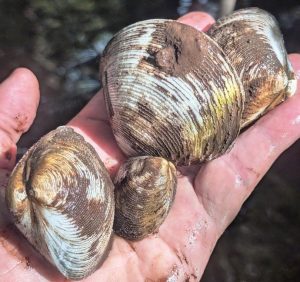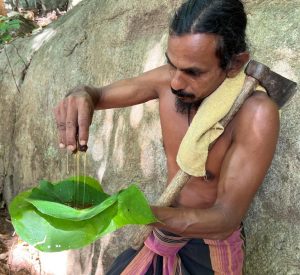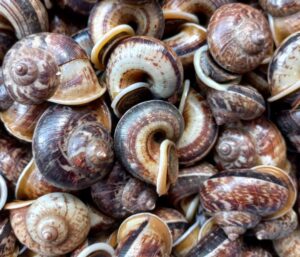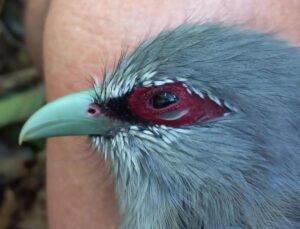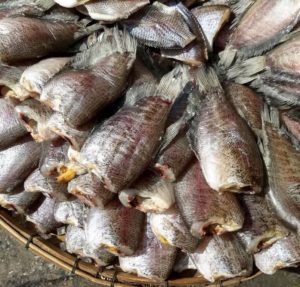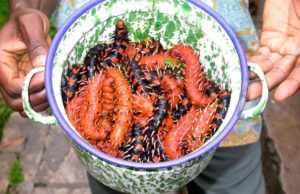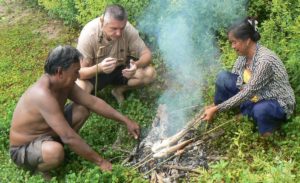Food from Animals
Mollusks in the inland waters of Siberut Island
In rivers, coastal zones, and mangrove forests, a diverse array of bivalve and gastropod species is collected and utilized for food. Bivalvia species Freshwater streams River clams (Batissa violacea) occur in large quantities in the lower zones of all slow-flowing…
Collecting honey from Dammar bees in Sri Lanka
The Rock Vedda people at Rathugala near Gal Oya in Sri Lanka collect honey from stingless Dammar bees. This last remaining band of Rock Veddas in Sri Lanka consists of 68 families, of which only ten of them still live…
Stingless bee honey collected by Hadza people
The Hadzabe people eagerly collect stingless bee honey all year long. They do this destructively by cutting open the hives in tree hollows, and both honey and brood are harvested and eaten. Foraging on these insects has not significantly affected…
Collecting honey in a rock crevice
Asian honey bees and their combs are a special treat for the local population of backcountry areas at Pu Luong Nature Reserve in northern Vietnam. The harvested honey is seldom sold and is mainly used by the villagers. The grubs,…
Catching mud crabs at Koh Lanta
Mud crabs are common in mangrove areas in Thailand. They are primarily caught in crab pots for commercial purposes. However, my Urak Lawoi friends and I specialized in digging up and catching these crabs by hand. Who are Urak Lawoi…
Edible rock snails in limestone areas of Vietnam
Rock snails of the genus Cyclophorus are highly sought-after wild foods in rocky limestone mountain areas of Vietnam. These snails are not only regarded as food but also as medicine against various ailments. The local Vietnamese name is Ốc thuốc,…
Domestic pigs as food by Mentawais
Domestic pigs are a typical gift from a Mentawai family to a shaman for his support or services. In our case, Aman Aru attended a ceremony in a neighboring Uma (family home in the forests), which had to be cleaned…
Sago worms of an unidentified species at Siberut Island
Sago worms are one of the food items that come naturally with the Mentawai’s staple food, sago flour. The worms grow in felled palm trunks or saplings. They are not worms but larvae and pupae of the Palm Weevil beetles…
Mentawai Shamanic Rituals: The Role of Sacrificial Chicken in Siberut Culture
Deep in the rainforests of Siberut Island, the Mentawai tribe food culture transcends simple nutrition, weaving a complex web between the physical world and the spirit realm. While their diet is traditionally rooted in sago and forest foraging, the domestic…
Animal species collected by rice farmers in the Red River Delta
Rice farmers in secluded areas of the Red River Delta in Northern Vietnam need dietary additions to their staple rice dishes. Vegetables are harvested from around their homes and surrounding tropical Evergreen forests. Animal proteins are mainly collected in and…
Green-billed Malkoha bird on the spit
The Green-billed Malkoha is a common bird in Vietnam’s semi-deciduous tropical forests. An expedition led to the capture of one who was cooked for lunch. This and other species are often hunted by villagers supplementing their diet with this and…
Some important edible caterpillar species in Kongo Central, Part 2
In former articles on this website, we already discussed two edible caterpillar species from Kongo Central. One species was ‘Bisu’ Nudaurelia petiveri, which was described here. And the other species was ‘Kaba’ Lobobunaea phaedusa, described in this article there. Additionally,…
Some important edible caterpillar species in Kongo Central, Part 1
In former articles on this website, two edible caterpillar species from Kongo Central were already discussed. One species was ‘Bisu’ Nudaurelia petiveri, which was described here. And the other species was ‘Kaba’ Lobobunaea phaedusa, described at this article there. In…
Utilizing Horseshoe Crabs as a Food Source
Foreword Horseshoe crabs are a species not protected in Thailand and are experiencing a significant decline. Their primary habitats, particularly the mudflats around mangrove forests, where they live and reproduce, are diminishing, and there is a growing demand for edible…
Eating centipedes in Yunnan Province, China
Eating insects and centipedes is a long tradition in Lijiang City, in Yunnan Province, P.R. China. In addition to centipedes, other insects such as bamboo worms, silkworm pupae, and locusts are also consumed. While they are high in protein and…
Semi-Dried Fish in Thailand
In Thailand, both sea and freshwater fish are dried to increase their shelf life for later human consumption. Before the advent of refrigeration, the primary method for preventing spoilage was to salt the fish and then leave it in the…
Canh Măng Mực: The Royal Dried Squid and Bamboo Soup of Bát Tràng
Experience the sophisticated flavors of Northern Vietnam with Canh Măng Mực, a rare, traditional Vietnamese squid-and-bamboo soup. Deeply rooted in the culinary heritage of the ancient Bát Tràng ceramic village near Hanoi, this dish is far more than a simple…
Weaver ants got interesting traits
Weaver ants of the genus Oecophylla consist of two different species. One species is Oecophylla longinoda, which occurs in equatorial, tropical African regions. The other species is Oecophylla smaragdina, distributed in tropical Asia and Australia. Both of them are also…
Mopane worms – high protein food in Africa
Mopane worms (Instars of Gonimbrasia belina) are mainly found on Mopane trees (Colophosperma mopane) but also on Wild Syringa (Burkea africana), Zebrawood (Microberlinia Brazzavillensis) and others. However, Mopane trees are a highly dominant species in climates and areas suitable for…
Field dressing and cooking a puff adder
Puff adders (Bitis arietans) are widely distributed throughout Sub-Saharan Africa, except in dense rainforest areas and Madagascar. They have a tell-tale flat head with a straight line between the eyes, a thick body with chevron markings, and a stumpy tail,…
African termite alates for food
In Southern Africa, Harvester termite alates (Hodotermes spp.) and Mound-building termite alates (Macrotermes spp.) swarm within a specific area usually once a year. These alates are winged termites, which termite workers keep within certain chambers in the mound. They represent…
Beekeeping in Congo, Central province
Honey hunting has been a traditional activity in Bas-Congo, as in much of Africa. But beekeeping in Congo has only been practiced in the area since the early 1980’s. The beehive in common use is the top bar hive which…
Skinning and processing of dormice in Slovenia
Before dormice can be skinned, processed, and cooked – they have to be caught. That is an art of its own and is described in an article under this Link here. Skinning and processing of dormice is done similarly to…
Green caterpillars, called ‘Kaba’ in D.R. Congo
The name Kaba is used for several large green caterpillars. Lobobunaea phaedusa can be up to 10 cm long and is usually found singly between October and May. When disturbed the caterpillar contracts in defence. They are sometimes very difficult…
Edible caterpillars Nudaurelia petiveri
This species (Nudaurelia petiveri) is widespread throughout western, central, and southeastern Africa. It appears in Kongo Central in December and January. Up to 200 eggs are laid in clusters on the undersides of young leaves. They hatch after about two…
Collection of edible caterpillars in D.R. Congo
Children are the main caterpillar collectors, though most people while walking in the bush, keep a constant watch for them. Frequently people will bring back young caterpillars and place them on trees near their homes where they can keep an…
Edible Caterpillars for food in Congo
Rural families in Kongo Central find it very difficult to get sufficient protein to eat. Hunting has cleared out most of the larger animals and even many of the smaller animals, such as the cane rat, are now difficult to…
Edible caterpillars in D.R. Congo – an introduction
My first experience with edible caterpillars took place in 1985 when my wife and I lived at Kavwaya near Kisantu in what was then the Bas-Congo province of D.R. Congo. On one occasion I was shown how to hunt for…
Pla Ra – Thailand’s fermented fish condiment
Pla Ra (Thai: ปลาร้า, pronounced [plāː ráː]), is fermented fish. Traditionally, Thais in the Central and Northeast provinces (Isan) eat fish and rice. In these relatively poor provinces, there is only one rice growing cycle every year. The planting season…
Drying meat in Shanghai at wintertime
It is at least a 2000-year-old tradition in many provinces in China to cure and preserve meat in wintertime. Pigs were slaughtered after the ‘Light Snowfall’ date (around Nov 22nd/23rd). Then, the temperatures plummeted, and this meat had to be…
Taste of Gaur meat at Kaeng Krachan rainforest
We were on a weeklong trail through the Kaeng Krachan rainforest, near Hua Hin in Thailand, when we tasted Gaur meat. Together with two National Park (NP) rangers, we came across a freshly died Gaur heifer. This Gaur (Bos gaurus)…
Pla Yang: Traditional Thai Open-Fire Spit Roasted Fish Guide
Grill spit for small fish outdoor cooking on a spit Smaller fish up to about 20 cm long are typically put on a grill spit, which is just a split stick. Often, in Thailand, this will be Pla Kod (Thai:…
Freshwater snails for food
In Thailand, two types of freshwater snails are commonly consumed. The first group is comprised of the larger Apple snails (Pomacea canaliculata), while the other group is referred to as Freshwater snails (Sinotaia sp. & Filopaludina sp.). These genera can…
Jellyfish for food and its preparation
Edible jellyfish (Aurelia sp.) is called ‘Maeng krapun jarn’ (Gulf of Siam) or ‘Lodchong’ (Andaman Sea) in Thailand. Usually, there are about three months a year when jellyfish appear for food. During this jellyfish run, sea fishermen earn a sizeable…
The Ultimate Survival Snack: Foraging and Preparing Ricefield Shrimp
Freshwater prawns, specifically Macrobrachium lanchesteri—locally known as Goong foi in Thailand—are one of the most efficient “survival foods” you can find in the wild. While they might be small, these translucent crustaceans are abundant in nearly every permanent water body…
Eating a sand monitor lizard (Goanna)
In the former article, I described seeing a majestic sand monitor lizard close by on my drive from Menzies to Sandstone on a side road. Driving further on, I was surprised to see many more Goannas left and right on…

